DODGE SPRINTER 2007 2.G Owners Manual
Manufacturer: DODGE, Model Year: 2007, Model line: SPRINTER, Model: DODGE SPRINTER 2007 2.GPages: 393, PDF Size: 7.61 MB
Page 191 of 393
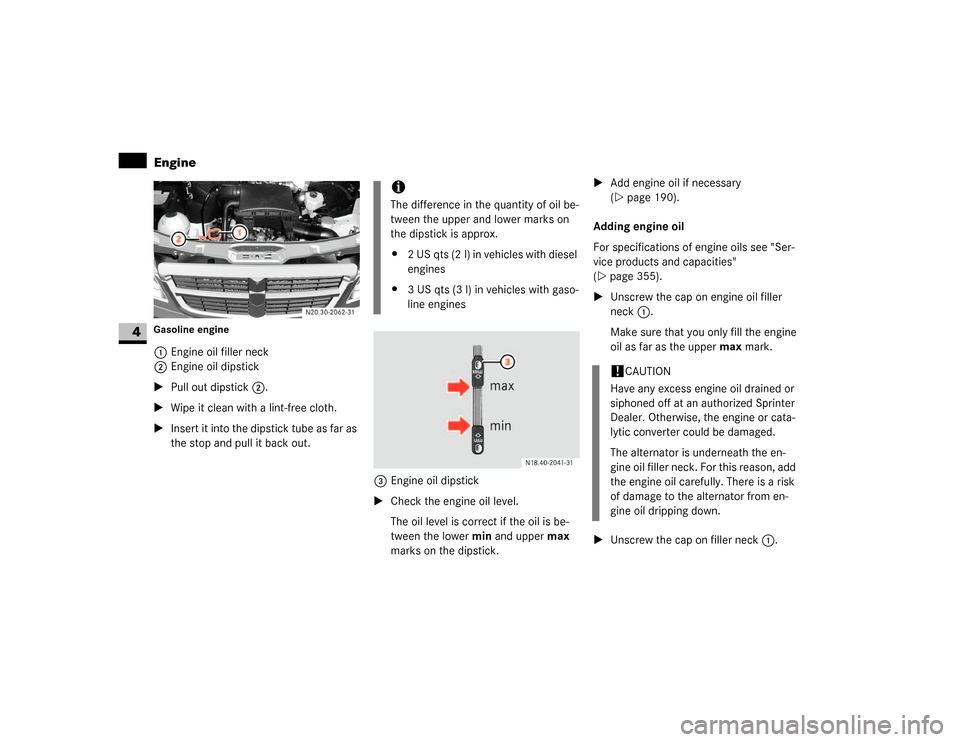
190 OperationEngine
4
Gasoline engine1Engine oil filler neck
2Engine oil dipstick
\1Pull out dipstick2.
\1Wipe it clean with a lint-free cloth.
\1Insert it into the dipstick tube as far as
the stop and pull it back out.
3Engine oil dipstick
\1Check the engine oil level.
The oil level is correct if the oil is be-
tween the lower min and upper max
marks on the dipstick.\1Add engine oil if necessary
(\2page 190).
Adding engine oil
For specifications of engine oils see "Ser-
vice products and capacities"
(\2page 355).
\1Unscrew the cap on engine oil filler
neck1.
Make sure that you only fill the engine
oil as far as the upper max mark.
\1Unscrew the cap on filler neck1.
iThe difference in the quantity of oil be-
tween the upper and lower marks on
the dipstick is approx.
\42 US qts (2 l) in vehicles with diesel
engines
\43 US qts (3 l) in vehicles with gaso-
line engines
N18.00-2041-31
!
CAUTION
Have any excess engine oil drained or
siphoned off at an authorized Sprinter
Dealer. Otherwise, the engine or cata-
lytic converter could be damaged.
The alternator is underneath the en-
gine oil filler neck. For this reason, add
the engine oil carefully. There is a risk
of damage to the alternator from en-
gine oil dripping down.
Page 192 of 393
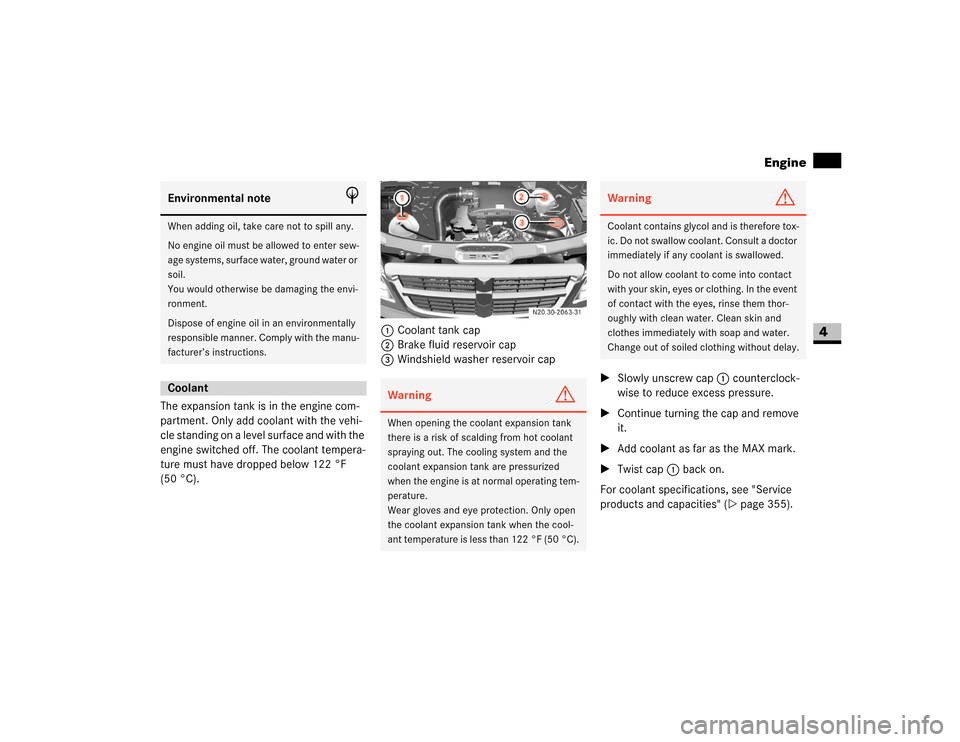
191 Operation
Engine
4
The expansion tank is in the engine com-
partment. Only add coolant with the vehi-
cle standing on a level surface and with the
engine switched off. The coolant tempera-
ture must have dropped below 122 °F
(50 °C).1Coolant tank cap
2Brake fluid reservoir cap
3Windshield washer reservoir cap
\1Slowly unscrew cap1 counterclock-
wise to reduce excess pressure.
\1Continue turning the cap and remove
it.
\1Add coolant as far as the MAX mark.
\1Twist cap1 back on.
For coolant specifications, see "Service
products and capacities" (\2page 355).Environmental note
H
When adding oil, take care not to spill any.
No engine oil must be allowed to enter sew-
age systems, surface water, ground water or
soil.
You would otherwise be damaging the envi-
ronment.
Dispose of engine oil in an environmentally
responsible manner. Comply with the manu-
facturer’s instructions.Coolant
Warning
G
When opening the coolant expansion tank
there is a risk of scalding from hot coolant
spraying out. The cooling system and the
coolant expansion tank are pressurized
when the engine is at normal operating tem-
perature.
Wear gloves and eye protection. Only open
the coolant expansion tank when the cool-
ant temperature is less than 122 °F (50 °C).
N20.30-2063-31
Warning
G
Coolant contains glycol and is therefore tox-
ic. Do not swallow coolant. Consult a doctor
immediately if any coolant is swallowed.
Do not allow coolant to come into contact
with your skin, eyes or clothing. In the event
of contact with the eyes, rinse them thor-
oughly with clean water. Clean skin and
clothes immediately with soap and water.
Change out of soiled clothing without delay.
Page 193 of 393
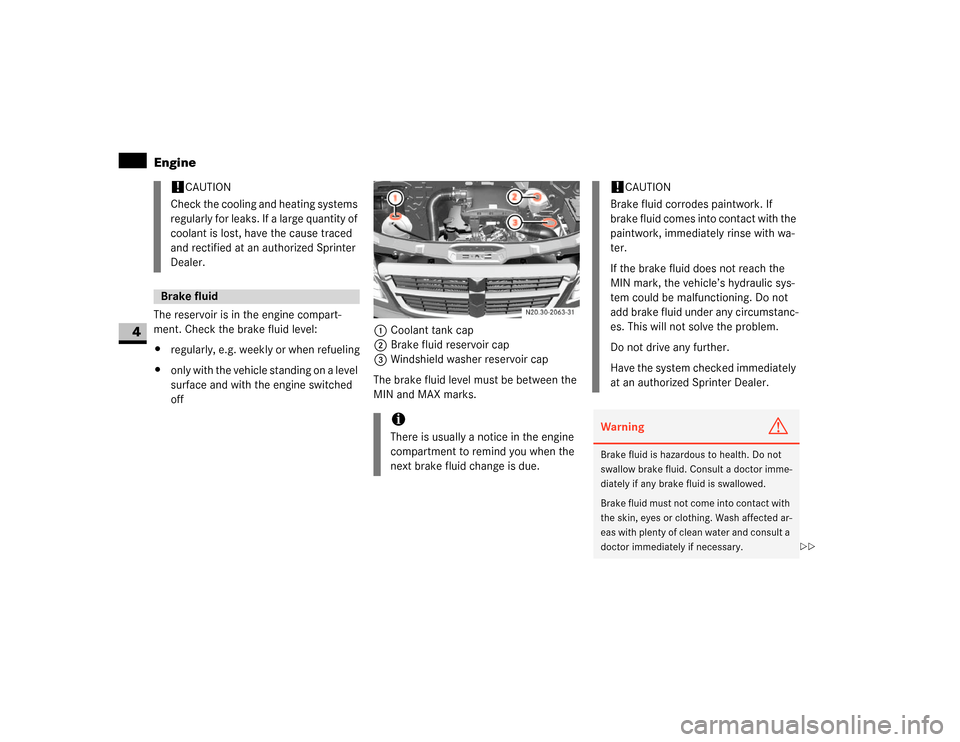
192 OperationEngine
4
The reservoir is in the engine compart-
ment. Check the brake fluid level:
\4regularly, e.g. weekly or when refueling
\4only with the vehicle standing on a level
surface and with the engine switched
off1Coolant tank cap
2Brake fluid reservoir cap
3Windshield washer reservoir cap
The brake fluid level must be between the
MIN and MAX marks.
!
CAUTION
Check the cooling and heating systems
regularly for leaks. If a large quantity of
coolant is lost, have the cause traced
and rectified at an authorized Sprinter
Dealer.
Brake fluid
iThere is usually a notice in the engine
compartment to remind you when the
next brake fluid change is due.
N20.30-2063-31
!
CAUTION
Brake fluid corrodes paintwork. If
brake fluid comes into contact with the
paintwork, immediately rinse with wa-
ter.
If the brake fluid does not reach the
MIN mark, the vehicle’s hydraulic sys-
tem could be malfunctioning. Do not
add brake fluid under any circumstanc-
es. This will not solve the problem.
Do not drive any further.
Have the system checked immediately
at an authorized Sprinter Dealer.
Warning
G
Brake fluid is hazardous to health. Do not
swallow brake fluid. Consult a doctor imme-
diately if any brake fluid is swallowed.
Brake fluid must not come into contact with
the skin, eyes or clothing. Wash affected ar-
eas with plenty of clean water and consult a
doctor immediately if necessary.
\2\2
Page 194 of 393
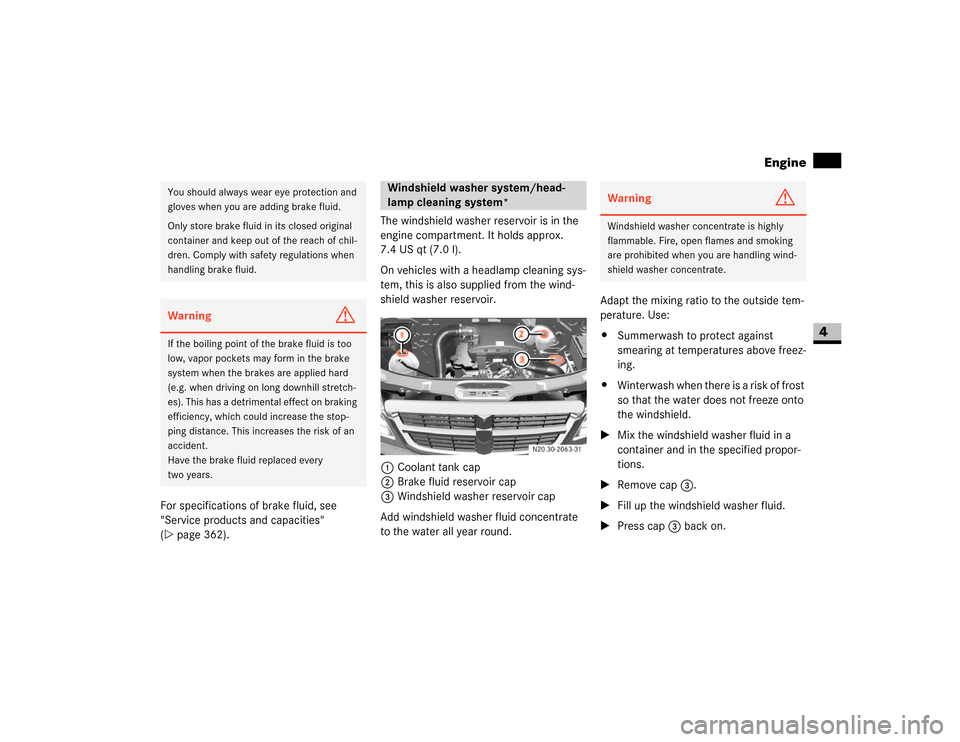
193 Operation
Engine
4
For specifications of brake fluid, see
"Service products and capacities"
(\2page 362).The windshield washer reservoir is in the
engine compartment. It holds approx.
7.4 US qt (7.0 l).
On vehicles with a headlamp cleaning sys-
tem, this is also supplied from the wind-
shield washer reservoir.
1Coolant tank cap
2Brake fluid reservoir cap
3Windshield washer reservoir cap
Add windshield washer fluid concentrate
to the water all year round.Adapt the mixing ratio to the outside tem-
perature. Use:
\4Summerwash to protect against
smearing at temperatures above freez-
ing.
\4Winterwash when there is a risk of frost
so that the water does not freeze onto
the windshield.
\1Mix the windshield washer fluid in a
container and in the specified propor-
tions.
\1Remove cap3.
\1Fill up the windshield washer fluid.
\1Press cap3 back on.You should always wear eye protection and
gloves when you are adding brake fluid.
Only store brake fluid in its closed original
container and keep out of the reach of chil-
dren. Comply with safety regulations when
handling brake fluid.Warning
G
If the boiling point of the brake fluid is too
low, vapor pockets may form in the brake
system when the brakes are applied hard
(e.g. when driving on long downhill stretch-
es). This has a detrimental effect on braking
efficiency, which could increase the stop-
ping distance. This increases the risk of an
accident.
Have the brake fluid replaced every
two years.
Windshield washer system/head-
lamp cleaning system*
N20.30-2063-31
Warning
G
Windshield washer concentrate is highly
flammable. Fire, open flames and smoking
are prohibited when you are handling wind-
shield washer concentrate.
Page 195 of 393
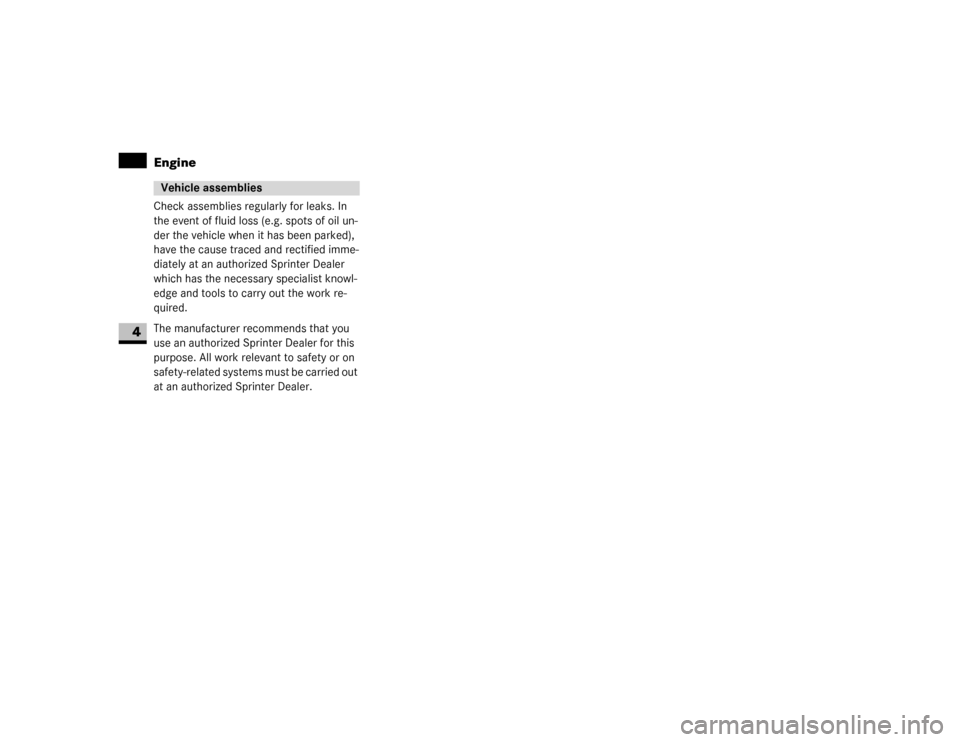
194 OperationEngine
4
Check assemblies regularly for leaks. In
the event of fluid loss (e.g. spots of oil un-
der the vehicle when it has been parked),
have the cause traced and rectified imme-
diately at an authorized Sprinter Dealer
which has the necessary specialist knowl-
edge and tools to carry out the work re-
quired.
The manufacturer recommends that you
use an authorized Sprinter Dealer for this
purpose. All work relevant to safety or on
safety-related systems must be carried out
at an authorized Sprinter Dealer.Vehicle assemblies
Page 196 of 393
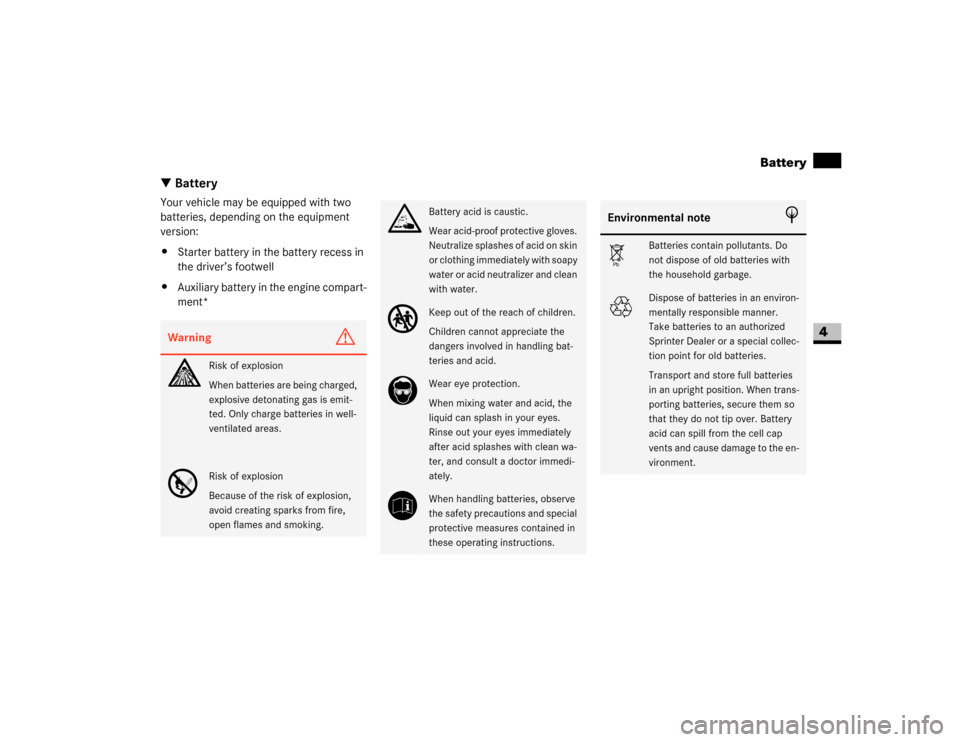
195 Operation
Battery
4
\3 BatteryYour vehicle may be equipped with two
batteries, depending on the equipment
version:
\4Starter battery in the battery recess in
the driver’s footwell
\4Auxiliary battery in the engine compart-
ment*Warning
G
A
Risk of explosion
When batteries are being charged,
explosive detonating gas is emit-
ted. Only charge batteries in well-
ventilated areas.
D
Risk of explosion
Because of the risk of explosion,
avoid creating sparks from fire,
open flames and smoking.
B
Battery acid is caustic.
Wear acid-proof protective gloves.
Neutralize splashes of acid on skin
or clothing immediately with soapy
water or acid neutralizer and clean
with water.
C
Keep out of the reach of children.
Children cannot appreciate the
dangers involved in handling bat-
teries and acid.
E
Wear eye protection.
When mixing water and acid, the
liquid can splash in your eyes.
Rinse out your eyes immediately
after acid splashes with clean wa-
ter, and consult a doctor immedi-
ately.
F
When handling batteries, observe
the safety precautions and special
protective measures contained in
these operating instructions.
Environmental note
H
Á
Batteries contain pollutants. Do
not dispose of old batteries with
the household garbage.
À
Dispose of batteries in an environ-
mentally responsible manner.
Take batteries to an authorized
Sprinter Dealer or a special collec-
tion point for old batteries.
Transport and store full batteries
in an upright position. When trans-
porting batteries, secure them so
that they do not tip over. Battery
acid can spill from the cell cap
vents and cause damage to the en-
vironment.
Page 197 of 393
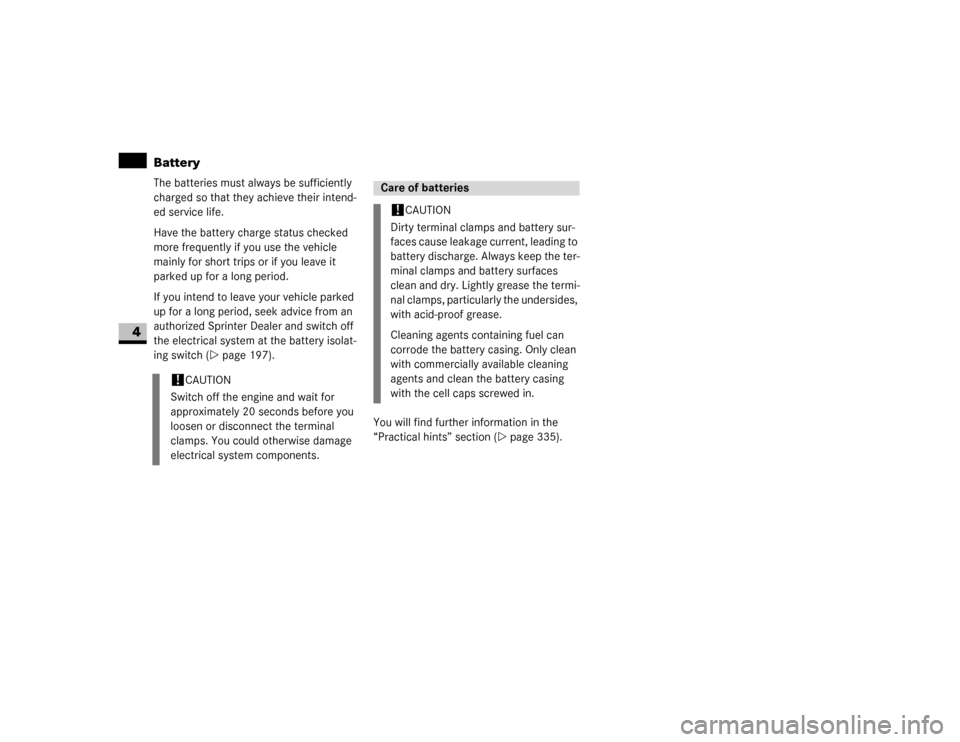
196 OperationBattery
4
The batteries must always be sufficiently
charged so that they achieve their intend-
ed service life.
Have the battery charge status checked
more frequently if you use the vehicle
mainly for short trips or if you leave it
parked up for a long period.
If you intend to leave your vehicle parked
up for a long period, seek advice from an
authorized Sprinter Dealer and switch off
the electrical system at the battery isolat-
ing switch (\2page 197).
You will find further information in the
“Practical hints” section (\2page 335).
!
CAUTION
Switch off the engine and wait for
approximately 20 seconds before you
loosen or disconnect the terminal
clamps. You could otherwise damage
electrical system components.
Care of batteries!
CAUTION
Dirty terminal clamps and battery sur-
faces cause leakage current, leading to
battery discharge. Always keep the ter-
minal clamps and battery surfaces
clean and dry. Lightly grease the termi-
nal clamps, particularly the undersides,
with acid-proof grease.
Cleaning agents containing fuel can
corrode the battery casing. Only clean
with commercially available cleaning
agents and clean the battery casing
with the cell caps screwed in.
Page 198 of 393
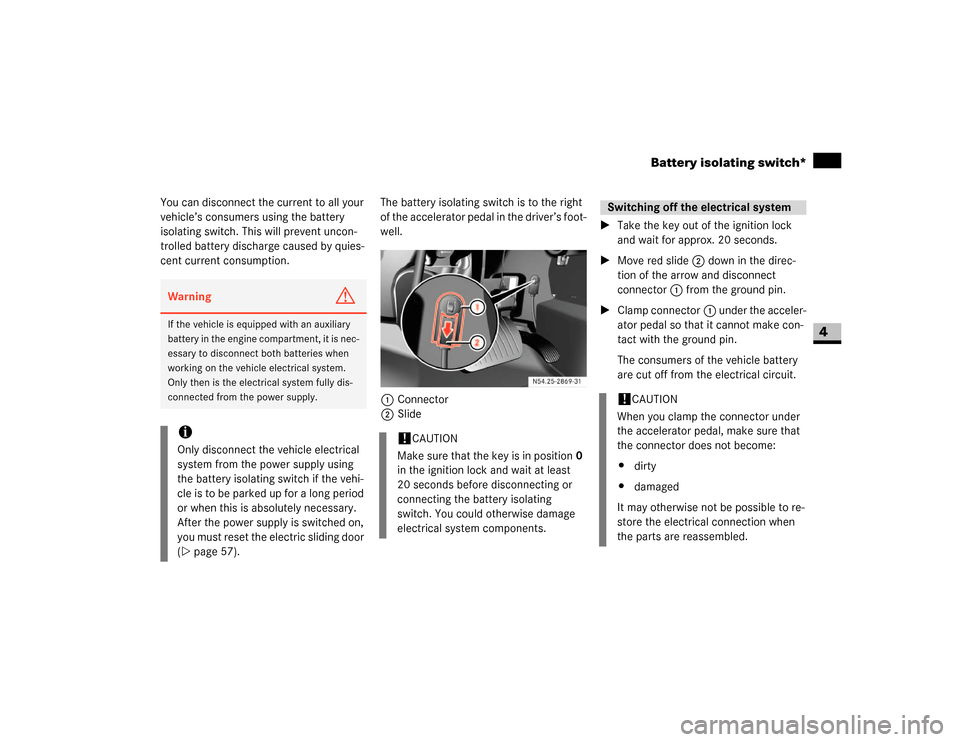
197 Operation
Battery isolating switch*
4
You can disconnect the current to all your
vehicle’s consumers using the battery
isolating switch. This will prevent uncon-
trolled battery discharge caused by quies-
cent current consumption.The battery isolating switch is to the right
of the accelerator pedal in the driver’s foot-
well.
1Connector
2Slide\1Take the key out of the ignition lock
and wait for approx. 20 seconds.
\1Move red slide2 down in the direc-
tion of the arrow and disconnect
connector1 from the ground pin.
\1Clamp connector1 under the acceler-
ator pedal so that it cannot make con-
tact with the ground pin.
The consumers of the vehicle battery
are cut off from the electrical circuit.Warning
G
If the vehicle is equipped with an auxiliary
battery in the engine compartment, it is nec-
essary to disconnect both batteries when
working on the vehicle electrical system.
Only then is the electrical system fully dis-
connected from the power supply.iOnly disconnect the vehicle electrical
system from the power supply using
the battery isolating switch if the vehi-
cle is to be parked up for a long period
or when this is absolutely necessary.
After the power supply is switched on,
you must reset the electric sliding door
(\2page 57).
!
CAUTION
Make sure that the key is in position0
in the ignition lock and wait at least
20 seconds before disconnecting or
connecting the battery isolating
switch. You could otherwise damage
electrical system components.
Switching off the electrical system!
CAUTION
When you clamp the connector under
the accelerator pedal, make sure that
the connector does not become:
\4dirty
\4damaged
It may otherwise not be possible to re-
store the electrical connection when
the parts are reassembled.
Page 199 of 393
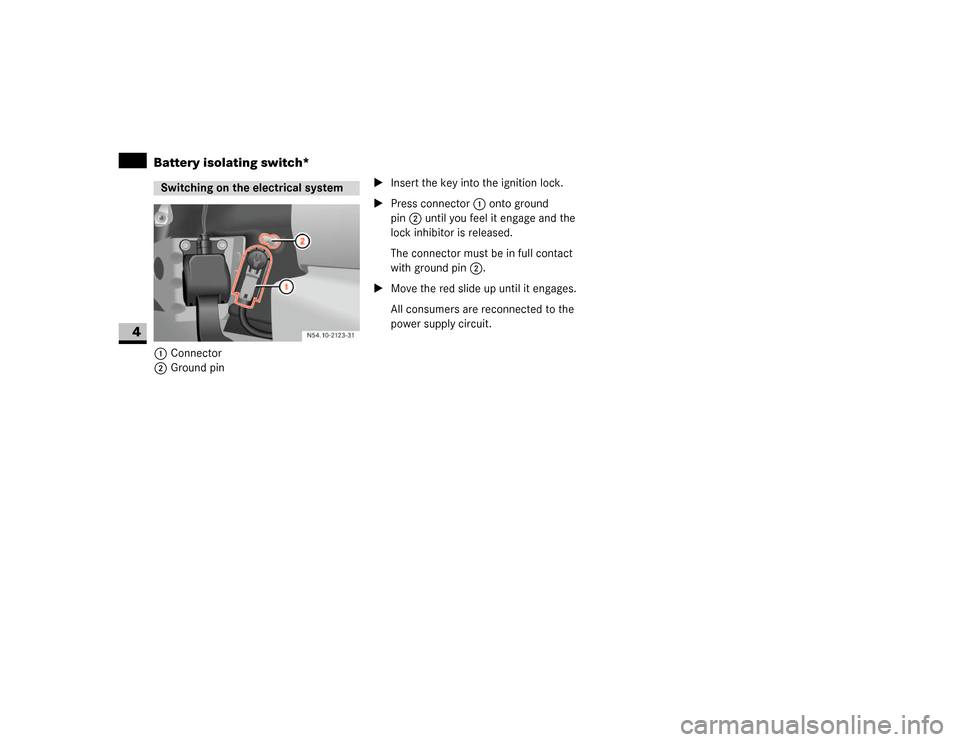
198 OperationBattery isolating switch*
4
1Connector
2Ground pin\1Insert the key into the ignition lock.
\1Press connector1 onto ground
pin2 until you feel it engage and the
lock inhibitor is released.
The connector must be in full contact
with ground pin2.
\1Move the red slide up until it engages.
All consumers are reconnected to the
power supply circuit.Switching on the electrical system
Page 200 of 393
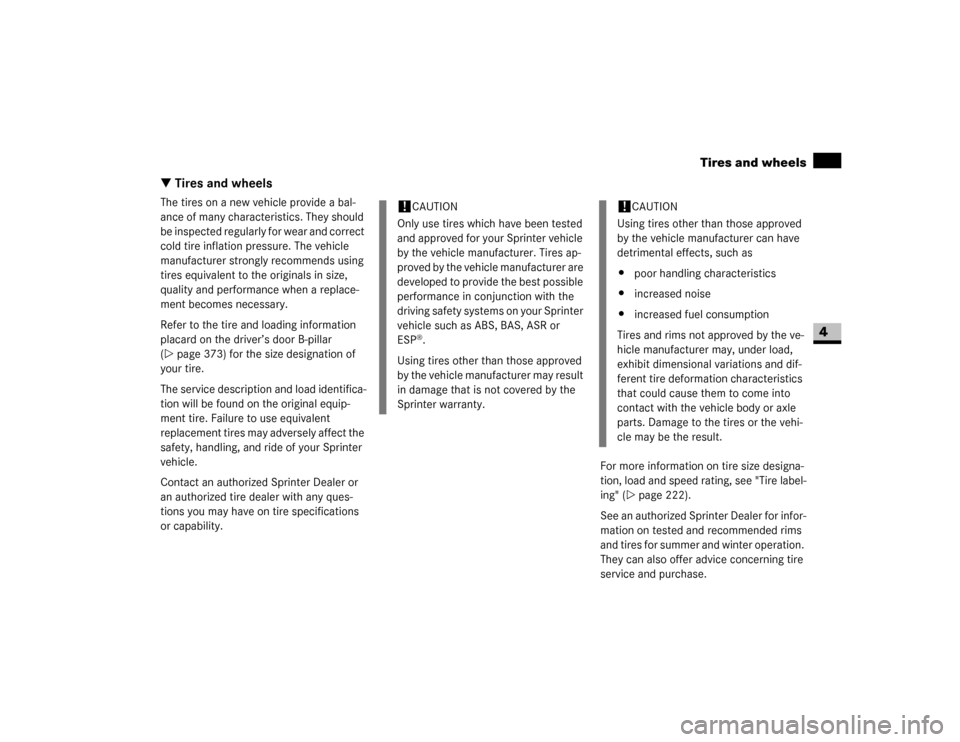
199 Operation
Tires and wheels
4
\3 Tires and wheelsThe tires on a new vehicle provide a bal-
ance of many characteristics. They should
be inspected regularly for wear and correct
cold tire inflation pressure. The vehicle
manufacturer strongly recommends using
tires equivalent to the originals in size,
quality and performance when a replace-
ment becomes necessary.
Refer to the tire and loading information
placard on the driver’s door B-pillar
(\2page 373) for the size designation of
your tire.
The service description and load identifica-
tion will be found on the original equip-
ment tire. Failure to use equivalent
replacement tires may adversely affect the
safety, handling, and ride of your Sprinter
vehicle.
Contact an authorized Sprinter Dealer or
an authorized tire dealer with any ques-
tions you may have on tire specifications
or capability.For more information on tire size designa-
tion, load and speed rating, see "Tire label-
ing" (\2page 222).
See an authorized Sprinter Dealer for infor-
mation on tested and recommended rims
and tires for summer and winter operation.
They can also offer advice concerning tire
service and purchase.
!
CAUTION
Only use tires which have been tested
and approved for your Sprinter vehicle
by the vehicle manufacturer. Tires ap-
proved by the vehicle manufacturer are
developed to provide the best possible
performance in conjunction with the
driving safety systems on your Sprinter
vehicle such as ABS, BAS, ASR or
ESP®.
Using tires other than those approved
by the vehicle manufacturer may result
in damage that is not covered by the
Sprinter warranty.
!
CAUTION
Using tires other than those approved
by the vehicle manufacturer can have
detrimental effects, such as
\4poor handling characteristics
\4increased noise
\4increased fuel consumption
Tires and rims not approved by the ve-
hicle manufacturer may, under load,
exhibit dimensional variations and dif-
ferent tire deformation characteristics
that could cause them to come into
contact with the vehicle body or axle
parts. Damage to the tires or the vehi-
cle may be the result.